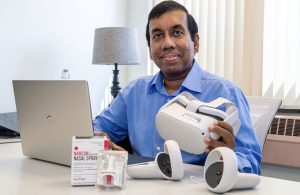SIU professor doing research to see if virtual reality can reduce opioid overdose deaths
By Christi Mathis — August 30, 2023
Wasantha Jayawardene belilevces a virtual reality-based training tool may offer the key to saving lives. (Photo courtesy of SIU)
In 2020, more than 90,000 people died in the United States of opioid overdose with half of those deaths occurring in their own homes. Southern Illinois University faculty member Wasantha Jayawardene and his colleagues believe a virtual reality-based training tool may offer the key to saving lives and they’ve received an Illinois Innovation Network seed grant to study their idea.
Jayawardene, who has dual appointments as assistant professor of public health in the School of Human Sciences at Southern Illinois University Carbondale and adjunct professor of population science and policy in the SIU School of Medicine, and his fellow researchers received a $30,000 seed grant for the project titled “Developing and Testing the Virtual Reality Embedded Naloxone Training (VENT).”
SIU is also providing equal matching funding, he said.
Death begins quickly
Jayawardene said many opioid deaths are preventable, but reaction must be quick and effective. Brain cells begin dying within 5 minutes after breathing stops, but the median time for an ambulance to arrive is 7 minutes and in many rural areas, it takes 14 minutes or even longer, studies indicate. He said in most cases, lives could be saved by the administration of naloxone, commonly known by its brand name Narcan. Delivering that life-saving medication can be as simple as using a nasal spray, he said.
“However, its current use by laypersons is negligible, even though it is now available without a prescription to anyone and using it can get an overdose victim breathing again,” he said.
Jayawardene said studies indicate that most people are just uncomfortable being the “good Samaritan” in real life, and although plenty of training programs exist, getting people to participate in them isn’t so easy.
Making it almost like a game
But what if the training was easy and perhaps fun? What if it was so laid back that it was almost like a video game, and after completing it, participants would be comfortable administering naloxone if they encountered a potential opioid overdose?
That’s where virtual reality comes in. The project uses state-of-the-art technology to deliver training via a mixed reality prototype that blends the virtual and physical worlds, using the actual spray device and a manikin along with a virtual reality training headset.
“The use of virtual reality in life support trainings can make the users feel immersed in their surroundings and improve learning engagement,” Jayawardene said.
Initially, a group of 15 laypeople and five experts with diverse backgrounds, including physicians, nurses, community health workers, researchers, community members, people who have family members with opioid prescriptions and others will “test drive” the virtual reality training module. The researchers will then modify the training based on the results and further field test it throughout the state to determine whether the VENT is superior to traditional community trainings in usability and preference. If the VENT model is found to be more effective, they will refine it and seek funding to implement the training on a larger scale, focusing on high-risk groups.
Additional factors
He noted that another component of the training is helping people understand the way the body works as well as the way opioids and naloxone work.
Essentially, opioids activate cellular proteins called receptors, which in turn affect how a cell carries out a task or releases chemicals, which release receptors in other cells. This can result in a variety of reactions or issues, including cessation of breathing.
However, if naloxone is administered, it competitively binds to the opioid receptors, acting like putty that prevents the receptors from being used and reversing their ongoing effects. Thus, pupils can dilate, and airways open up so people can breathe.
Timing is everything though, Jayawardene said. The medication typically takes just 2-3 minutes to take effect, but a second dose 2-3 minutes later is needed if the initial dose isn’t effective, and an additional dose won’t have adverse effects, Jayawardene said. While naloxone is only effective in reversing opioid overdoses, it won’t harm an individual who is overdosing from other drugs like cocaine or someone who isn’t actually overdosing, he said.
Surprisingly, naloxone isn’t new. It’s been available since the early 1960s and approved by the FDA since 1971, long before opioids became the societal problem it is today, Jayawardene noted. Yet its distribution and use remains minimal. For instance, of the 13.5 million Americans who were prescribed large daily doses of opioids in 2018, less than 1 percent received naloxone, according to the Centers for Disease Control. Those statistics don’t take into account the large number of people who illegally use opioids.
The deaths of 91,799 people in 2020, the last year for which CDC numbers are available according to Jayawardene, represented a 31 percent increase from the 2019 total. He said experts speculate that the COVID-19 pandemic may have accounted in part for the increase.
Jayawardene is also utilizing SIU’s Social Perception Lab in conjunction with the opioid research project, assessing the degree to which someone’s subconscious bias against people with drug addiction or even bias toward people who self-manage chronic pain through the use of opioids affects how they respond when someone suffers an overdose. Participants in the new education prototype are given the Implicit Association Test, which can reflect any implicit bias they have, before they test the VENT prototype.
“The VENT will incorporate a model that addresses implicit bias, which can help responders become more aware of their own biases and their potential impact on helping victims in real-life scenarios,” Jayawardene said.
The research team also includes Roy Magnusson, associate professor of creative technologies at Illinois State University (ISU); Joanna Willett, director of the Nursing Simulation Lab at ISU; and Scott Barrows, director of the OSF HealthCare Jump Design Lab.







